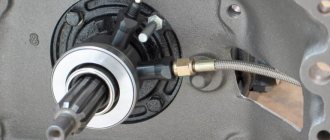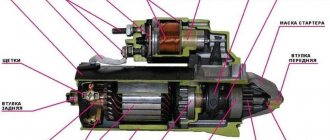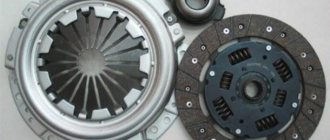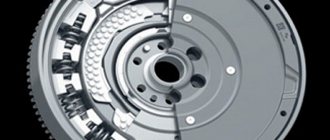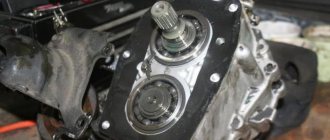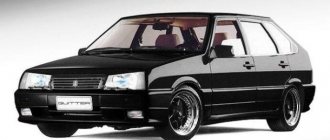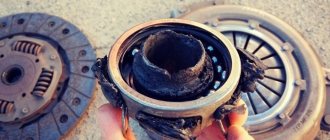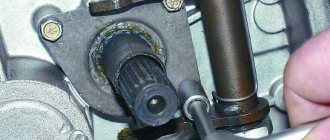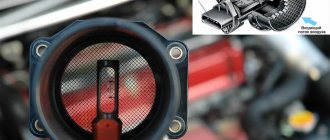01/24/2022 5,574 Transmission
Author: Victor
The release bearing is one of the main clutch elements in a car. Its wear and tear will lead to system malfunctions, resulting in the need to replace the device. In this article we will talk about what signs of malfunction are typical for a release bearing and what the failure of this part can mean for the car.
[Hide]
Types of release bearings
Before we find out the reasons for the failure and what problems the wear of the bearing device will bring for an Accent car or another model, let’s look at the types of parts.
Today, two types of devices are used in clutch and gear shift systems:
- Ball or roller. Mechanical parts during operation of which force is transmitted through a rigid bunch of rods.
- Hydraulic elements. In such devices, force is transmitted via hydraulics. This allows the driver to depress the clutch pedal more easily. Almost all new cars are equipped with hydraulic bearings.
- Mechanical. Practically not used. Previously, Russian-made cars were equipped with such parts.
Principle of operation
The release bearing can be either push-action or pull-out. It turns the mechanism on and off. The clutch basket is connected to the disc. Today two types of these bearings are produced:
- Roller;
- Hydraulic.
The clutch is used to smoothly disengage the engine from the transmission when changing gears. This approach protects transmission elements from excessive overloads and malfunctions.
One side of the release bearing is made as a round pressure pad, comparable to the diameter of the release springs, located in the center of a part called the clutch basket.
Roller
The release bearing is located on the input shaft protruding from the gearbox, but it is attached to the shaft protective casing and drives the drive fork (rocker arm). The latter presses on a pressure mandrel equipped with special protrusions. The hub moves freely to the input shaft. Damper springs located inside dampen torsional vibrations, they ensure smooth activation.
The pressure plate with the diaphragm spring and the housing form a block called the clutch basket. To create the required force, a diaphragm spring presses on the pressure plate. Inside it is made like metal petals, which are acted upon by a release bearing. It is placed on the axis of rotation as a transmission device connecting the drive to the clutch. The fork (rocker arm) is designed to move the release clutch with the bearing.
Hydraulic
Operating principle
The purpose of the device is to ensure uninterrupted connection and disconnection of the clutch discs when the driver presses the pedal.
The operating principle is as follows:
- Through the action of the pressure plate, the driven shaft is pressed against the clutch flywheel.
- The system generates pressure, which is applied to the pressure shaft; this is ensured through the use of a diaphragm spring. Its inner petals are affected by a bearing device.
- The part moves, resulting in separation of the shafts through the action of the fork.
User Alexey Romanov published a video that will help you understand the principle of operation of the clutch system and release bearing.
How much does a new clutch cost?
Entire clutch kits for the VAZ-2110 are now on sale. The price is 2400 rubles (). The kit includes:
- Driven clutch disc.
- Release bearing.
- Clutch basket.
The catalog number of this product is 2110-1601000-00.
This kit is suitable for VAZ cars of the “tenth” family, as well as Lada Granta. The weight of the set is 4.4 kilograms.
Causes and signs of failure
If the bearing has fallen apart or is just failing, this will lead to problems with the clutch system.
If a bearing fails, it is usually because the unit has worn out from constant use under high loads. Often the cause of a worn and broken unit is holding the clutch pedal in gear for a long time. When a driver makes such a mistake while idling in traffic jams, heavy loads are placed on the device, which leads to its breakdown. Why other parts fail is due to natural wear and tear. If the bearing element is faulty, this can be determined by certain symptoms.
What are the typical signs of failure for a release bearing?
- The main sign of a failed component is the appearance of extraneous sound. This is usually a noise or knocking noise that can be heard when you depress the clutch pedal of your car. The type of sound may vary. Sometimes the device makes a quiet noise, crunches, crackles or knocks loudly. The louder the sound, the more likely it is that the device has worn out and fallen apart.
- If the part does not squeak, signs may manifest itself in difficulties in operating the machine. Sometimes the driver fails to reach a certain speed. In some cases, when the car starts moving, it jerks uncharacteristically.
- Slipping or incomplete disengagement of the clutch. When the driver releases the pedal, slippage occurs and a burning smell appears.
- The pedal free play has increased. The dynamics of the vehicle deteriorate, the car moves unevenly.
- Sometimes the failure of the release bearing leads to increased fuel consumption and even overheating of the engine.
The channel “VAZ 2101-2107 REPAIR AND MAINTENANCE” published a video from which you can learn about malfunctions, as well as diagnostics of the release bearing device.
Where is it used?
Automakers use this element on systems with two disks - a slave and a master. The first element receives torque from the second and transmits it to the transmission. Further, through the cardan transmission, the force is transmitted to the gearbox, and then to the wheels. The drive disc is tightly secured to the crankshaft. In order for the driver to move from one gear to another (no matter whether it is high or low), it is necessary to separate these two elements. This operation is carried out precisely thanks to the bearing. The force is controlled by pressing the clutch pedal. When it is pressed to the floor, the transmission of torque stops - the bearing rotates at the same speed as the flywheel. As it is released, the two disks are connected to each other. At this time, high loads are observed on the clutch release bearing. Malfunctions of these elements arise precisely because of heavy loads.
It is worth noting that while driving, when the car is in gear, this element is in a calm state. But as soon as you need to switch to the next or previous speed, it immediately starts working. Despite its small size, this element performs an important function. In the event of any malfunction, further operation of the vehicle will be impossible or difficult. Therefore, at the first symptoms you should pay attention to it. What signs of malfunction does the clutch release bearing have (Kalina included), we will consider further.
Changing the release bearing
More information on how to remove and dismantle the bearing device from the coupling:
- Remove the gearbox. This will provide free access to all components and elements of the transmission and clutch system.
- Disengage the spring fastening from the coupling. To do this, use a screwdriver or other available tool.
- Dismantle the failed release bearing from the guide bushing. To do this, you will need to press out the 4 latches of the spring fastening and remove it. After removing the device from the coupling, carefully inspect the device for any defects or malfunctions. Make sure that the part has failed and needs to be replaced.
- Before changing and installing a new bearing, it must be checked. Delays during rotation of the device are not allowed, as are gaps. If the part is operational, then replace the coupling. When installing, make sure that the inner protruding part of the ring is directed to the side. After installation, the element must be secured with a fastener.
- Lubricant is applied to the guide, after which the bearing device is installed. The part is secured using a holder.
- The removed gearbox is installed and the functionality of the device is checked.
1. Remove the gearbox from the car
2. Disconnect the fastener from the coupling
3. Squeeze out the four fasteners and change the part
Removing the gearbox
The procedure for dismantling the gearbox can be performed differently depending on the design features of the machine. Removal of the unit should be carried out with an assistant. Before dismantling, the vehicle battery is disconnected and removed, as well as the transmission fluid is drained.
How to remove the gearbox:
- Disconnect the clutch pedal cable. Remove it from the bracket.
- Disconnect the block with wires from the speed sensor installed on the box. Be careful not to damage the connector. To turn it off, press the latches.
- Using a wrench, unscrew the bolts that secure the ignition module bracket to the gearbox. Also unscrew the screws securing the transmission to the power unit.
- You will see connectors on the bottom of the gearbox; they need to be disconnected.
- Remove all screws that secure the torque rod bracket to the transmission housing. It is necessary to loosen the clamp of the rod clamp, which is designed to change gears. Disconnect this element from the hinge.
- Dismantle the wheel drives. Remove another nut that secures the transmission to the engine.
- Unscrew the three screws and remove the gearbox housing cover. It remains to unscrew one more bolt that secures the unit to the engine.
- Under the bottom of the car, find the nuts that secure the left and rear engine support of the car. After this, the gearbox must be carefully moved along the guides. Dismantling the gearbox is carried out with the help of a partner. Replace the release bearing and reinstall the gearbox. Fill with new oil.
1. Disconnect the plug and wire from the speed control sensor
2. Use a wrench to unscrew the screws securing the bracket
3. Remove the screw securing the gearbox to the engine
4. Dismantle the vehicle wheel drives
How to extend the resource?
To increase the service life of the device, you must drive on smooth roads. In our country, it is problematic to comply with this condition. Keep in mind that uneven roads destroy not only the vehicle’s chassis, but also the clutch system. Therefore, regular off-road driving is also dangerous for bearings. Don't make mistakes when operating your car. When the car is stopped at a traffic light, there is no need to depress the clutch pedal and engage first gear if you do not plan to move. This should only be done at the beginning of movement, since the part operates under high load conditions. Regular lubrication will increase the service life of the device.
Video “Guide to replacing and lubricating parts”
Channel “Engine Repair! And interesting!” offers to familiarize yourself with the procedure for replacing the release bearing device and its lubrication in its roller.
Do you have any questions? Specialists and readers of the AUTODVIG website will help you ask a question
Was this article helpful?
Thank you for your opinion!
The article was useful. Please share the information with your friends.
Yes (83.33%)
No (16.67%)
X
Please write what is wrong and leave recommendations on the article
Cancel reply
Rate this article: ( 6 votes, average: 4.83 out of 5)
Discuss the article:
